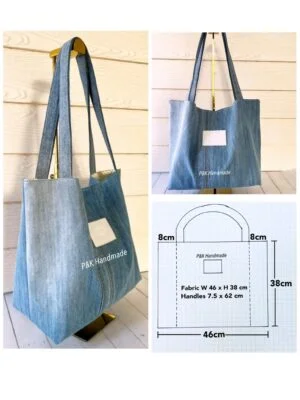Repurposing old jeans into a beautiful handmade bag is one of the most rewarding DIY projects you can take on. Not only do you give new life to fabric that might otherwise go to waste, but you also create a stylish and sturdy accessory that reflects your personality. With just a few sewing skills and some creativity, you can transform denim into a unique bag that you’ll love to carry everywhere.
In this tutorial, we’ll walk through the entire process step by step, from gathering your materials to adding final custom touches. You’ll also see how quilt techniques and quilt patterns can be incorporated into your bag design to give it extra charm and structure. This guide is written with beginners in mind, so don’t worry if you’ve never tried making a bag before.
By the end of this project, you’ll have a durable denim bag that can serve as a tote, a casual handbag, or even a school or shopping bag. The beauty of denim is its versatility—it pairs well with just about any outfit and is strong enough to handle daily use. So, let’s dive in and start creating!
Materials You’ll Need
Before you begin cutting and sewing, it’s important to gather all the necessary materials. The good news is that most of these items are probably already in your home. Using recycled denim makes this project not only budget-friendly but also eco-conscious.
Here’s what you’ll need:
- One or two pairs of old jeans (depending on the bag size)
- Lining fabric (cotton, canvas, or even a quilt fabric)
- Scissors or rotary cutter
- Sewing machine with denim needle
- Thread (denim or polyester)
- Pins or sewing clips
- Measuring tape or ruler
- Iron
- Optional: quilt batting, zipper, or magnetic snap closure
Think of the lining fabric as a chance to add personality. You can select a bright cotton with a quilt pattern, a soft pastel print, or even a bold geometric design. Adding quilt batting between the denim and lining can provide extra structure, making the bag sturdier and giving it a professional finish.
The great thing about denim is that it works well with almost any material. Pairing it with quilt fabric inside your bag not only looks attractive but also shows how quilting techniques can enhance practical sewing projects.
Preparing the Denim
The first step is preparing your denim pieces. Start by laying the jeans flat on a large table or workspace. Cut along the seams to separate the legs, waistband, and pockets. Denim is thick, so sharp scissors or a rotary cutter will make the job easier and more precise.
Decide on the size of your bag. A common tote bag size is around 16 inches wide by 14 inches tall, but you can customize this depending on your needs. Cut two rectangular pieces of denim in your chosen size. These will form the front and back panels of your bag. If you want, you can incorporate the jeans’ back pockets into the design by cutting panels that include them.
At this stage, consider using quilt techniques to piece together smaller scraps of denim. Instead of large rectangles, you could create patchwork panels with different shades of blue. A quilt pattern made with denim strips, squares, or triangles can add an artistic and creative look to your bag.

Cutting the Lining and Optional Batting
Once your denim panels are ready, it’s time to prepare the lining fabric. Place your denim panels on the lining material and trace around them, cutting two identical pieces. If you are adding quilt batting for structure, also cut two pieces of batting the same size.
The lining is what gives the bag a neat interior and helps it last longer. Choosing a fabric with a quilt pattern or colorful print can make opening your bag a delight every time. For a sturdier bag, you can even quilt the lining fabric onto the batting before sewing it to the denim panels.
If you’re feeling creative, you could also add an interior pocket. Simply cut a smaller rectangle of fabric, hem the edges, and sew it onto one of the lining panels before assembling the bag. It’s a small touch that adds functionality and makes your handmade bag more professional.
Assembling the Bag Body
Now it’s time to bring everything together. Place the two denim panels right sides facing each other, and sew along the sides and bottom, leaving the top open. Use a ½-inch seam allowance, and don’t forget to backstitch at the beginning and end for durability.
Do the same with your lining panels, but leave a 3-inch opening along the bottom edge. This opening will allow you to turn the bag right side out later. If you added quilt batting, sew it together with the lining so it stays in place.
To give your bag a boxy shape, create a flat bottom. Pinch each bottom corner so that the side seam and bottom seam line up, forming a triangle. Measure about 2 inches from the tip and sew across. Trim the excess fabric. Repeat this for all four corners—two on the denim and two on the lining.
Making the Handles
A denim bag wouldn’t be complete without strong handles. You can make them from leftover denim strips or use sturdy cotton webbing. If you choose denim, cut two strips about 24 inches long and 3 inches wide. Fold each strip in half lengthwise, right sides together, and sew along the edge. Turn them right side out and press with an iron.
For added strength, topstitch along both sides of each strap. This not only reinforces the handles but also gives them a polished, store-bought look. You can also quilt the handles by stitching a simple quilt pattern along their length, which adds both texture and durability.
Position the handles on the right side of the denim bag body, about 4 inches from each side seam. Pin them in place with the ends pointing downward into the bag opening. Make sure they’re even, then baste them in place with a short row of stitches.
Attaching the Lining
With the handles secured, it’s time to attach the lining. Place the denim bag inside the lining bag, right sides facing each other, and align the top edges. Pin around the top, making sure the handles are tucked between the layers.
Sew all the way around the top edge using a ½-inch seam allowance. Once sewn, pull the denim bag through the opening you left in the lining. Gently push out the corners and edges until everything is in place. Then, sew the lining’s opening closed with a straight stitch or ladder stitch.
Finally, press the top edge of the bag flat with an iron and topstitch around it for a crisp finish. This step also strengthens the seam, ensuring your bag holds up to daily use.
Ideas for Personalization
One of the best parts of making your own denim bag is customizing it to your style. You can keep it simple and classic, or you can add creative details that make it truly one-of-a-kind. Here are a few ideas:
- Patchwork Quilting: Sew different shades of denim together in a quilt pattern like half-square triangles, log cabin, or star blocks.
- Embroidery: Add colorful embroidery designs or initials to the front panel for a personalized touch.
- Appliqué: Use leftover quilt fabric to cut shapes (like hearts, flowers, or stars) and stitch them onto the denim.
- Decorative Stitching: Use contrasting thread to create visible quilting stitches across the denim for added texture.
Personalizing your bag is where creativity shines. Every stitch can tell a story, and by incorporating quilt techniques, you elevate a simple denim bag into a functional piece of art.
Final Touches and Enjoying Your Bag
Once your bag is complete, take a moment to admire your work. You’ve transformed old jeans into something fresh, useful, and stylish. The durability of denim combined with the charm of quilt fabric and quilt patterns ensures that your bag is not just practical but also a statement of creativity.
Whether you use it for shopping, school, or as an everyday tote, your handmade bag will stand out and receive compliments. It’s also an eco-friendly choice, reducing textile waste while allowing you to practice your sewing and quilting skills.
If you enjoyed this tutorial, don’t keep it to yourself! Share your denim bag project with friends, family, or on social media. Inspire others to try their hand at making something new from something old. Who knows—you might even start a trend of turning jeans into stylish quilt-inspired bags!
